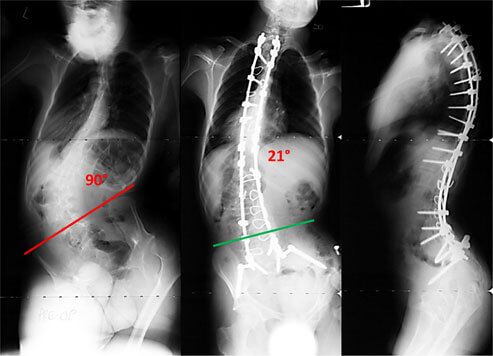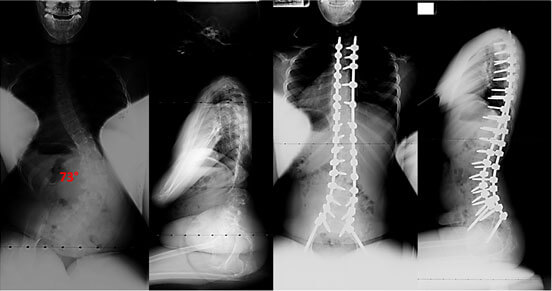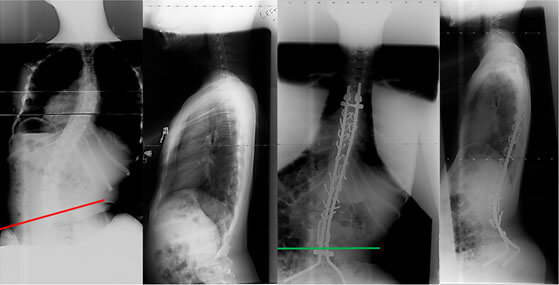Neuromuscular Scoliosis
Neuromuscular scoliosis is lateral (side) curvature of the spine that is caused by various neuromuscular conditions. These include cerebral palsy, muscular dystrophy, polio, spinal muscular atrophy, and post spinal cord injury conditions, in addition to other diseases. Patients afflicted with these conditions often develop scoliosis and/or kyphosis or round back. This is frequently associated with back pain, difficulty sitting in a wheelchair, and loss of walking ability over time. Those individuals who are severely involved may also develop lung dysfunction due to recurrent pneumonia or bronchitis or simply from restriction of the thorax (chest). Some patients have special needs as a result of intellectual impairment, often seen in conditions such as cerebral palsy.
Treatment of patients with neuromuscular scoliosis is tailored to the particular problem (e.g., pain, sitting difficulty) as well as the severity and the location of the curvature. Nonoperative treatment includes bracing for patients who have flexible curves that are under 50 degrees. For those who are nonambulatory, modification of the wheelchair can be done in order to assist in sitting comfort and balance.
Surgical treatment is reserved for those patients who have progressive curvature that interferes with function or is likely to cause difficulties in the years ahead. Patients with muscular dystrophy are treated once curvature reaches 20 degrees or more. This early surgery is done to preserve lung function and ambulatory potential. Surgical treatment is otherwise generally performed for curvature over 50 degrees for most patients. Often, when pelvic asymmetry or obliquity occurs in conjunction with severe curvature, the surgery incorporates the spine and the pelvis in order to correct the pelvic obliquity and spinal imbalance. This can be done through a posterior (back) approach or a combined anterior (front) and posterior approach, depending on the severity of the curvature and the need for additional support in the front of the spine. Success in these patients is measured by the ability to rebalance the spine and to preserve function and comfort and allow meaningful interaction of the patient with his or her environment and family. Although many of these patients are significantly disabled, they can often live fulfilling and productive lives.
Patient Story 1
Luke came to see Dr. Lonner with his family from Great Britain. He has Cerebral Palsy and had a severe progressive scoliosis with pelvic obliquity (tilting of the pelvis) which made it difficult for him to sit. He also had a lot of pain. His parents did everything they could for Luke to try and avoid surgery. They even took him to Hungary for specialized physical therapy. Despite great difficulty in speaking, Luke is highly intelligent. Dr. Lonner performed surgery, corrected his severe scoliosis and pelvic obliquity making Luke’s sitting much more comfortable and allowing him to function better.

Patient Story 2
Alexandra was a 10½ years old girl with type III spinal muscular atrophy and had been wheelchair bound since the age of 5 when she came to see Dr. Lonner. Despite being braced for scoliosis, the curvature progressed significantly over the years. Surgery performed by Dr. Lonner successfully corrected her scoliosis and pelvic obliquity to almost 0 degrees. She remained well aligned, sat comfortably, and was much more functional and is currently a college student doing very well.

Patient Story 3
David was a 15 years old young man with severe progressive scoliosis and pelvic obliquity associated with Duchenne’s muscular dystrophy when he presented to Dr Lonner for surgical treatment. He was wheelchair bound, experiencing tremendous back pain. Dr. Lonner performed corrective surgery to arrest curvature and to minimize pulmonary compromise. David did very well after surgery, his alignment was restored and his pelvis was leveled, his pain improved greatly and he went off to college. His father was so dedicated to David that he drove him to college parties on the weekends and slept in the vehicle waiting for the parties to end so David could have a “full” college experience.

